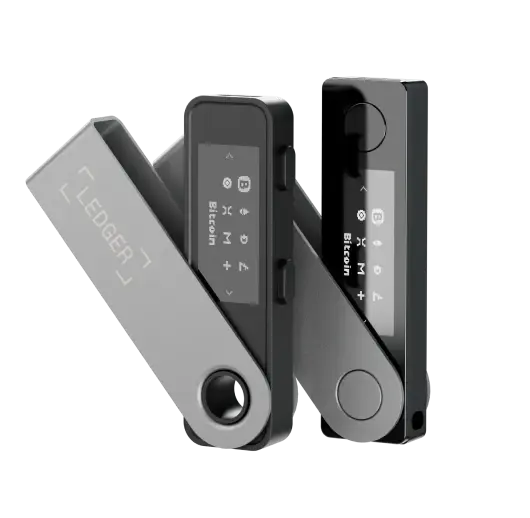Get a Ledger Nano
Select and purchase a Ledger hardware wallet of your choice.
- Beginner in the crypto world? Get started with Ledger Nano S Plus.
- Prefer a Bluetooth connection? Try with Ledger Nano X.
Looking for a Bitcoin Wallet to buy and store your BTC? Join 6+ million customers who trust Ledger hardware wallets to securely store their crypto such as Bitcoin and use them on the day-to-day basis.
Trusted by over 6 million customers

Whether you’re looking to keep your crypto safe for long-term or manage them on a daily basis, Ledger has the right product for you.
Ledger hardware wallet
Ledger hardware wallet stores your private keys and signs transactions offline, making them resistant to malicious attacks and threats. Pair the Ledger crypto wallet with Ledger Live App to manage your Bitcoin (BTC) on the go.
Ledger Live App
Ledger Live App is a gateway to manage your assets, checking your real-time balance, tracking transaction histories, and more.

Select and purchase a Ledger hardware wallet of your choice.

Download and install the Ledger Live app in a couple of clicks on desktop and mobile.
Coupled with a Ledger, it makes the most secured wallet for your Bitcoin.

Add a Bitcoin (BTC) account with a couple of clicks. Choose among different providers and easily manage your BTC.
And not only Bitcoin. With Ledger Live, you can manage thousands of crypto and a large variety of NFTs.

With Ledger Live coupled with a Ledger, you can:
*Buy, send/receive, swap, stake, and other crypto transaction services are provided by third-parties provider, which availability may vary based on jurisdiction/territory.

You can buy Bitcoin (BTC) with a credit/debit card or bank transfer. You can choose from a range of service providers (MoonPay, Paypal, Ramp, Sardine…) and select the option that works best for you.
Your Bitcoin will land in your Ledger Bitcoin Wallet.

Swapping allows you to explore different crypto assets, protect your Bitcoin (BTC) from volatility, and diversify your portfolio.
You can easily swap Bitcoin through Ledger Live without using fiat currencies.


The most premium secure touchscreen hardware wallet to protect and manage your Bitcoin.

Designed with accessible sizing, enjoy the all new secure touchscreen user experience to manage your Bitcoin.

Our classic entry-level hardware wallets built with all the essentials to secure your Bitcoin.
Bertil A.
5/5In order to secure cryptocurrencies, Ledger is the perfect tool.
Kevin L.
5/5Simply a very elegant peace of hardware, with a gorgeous UI in the app.
James P.
5/5ALL is good, all legal resources bought was as specified and compliant, party on.
A Bitcoin wallet stores private keys, which are strings of characters that allow you to manage a Bitcoin address. Your Bitcoin wallet contains private keys, which are a special series of characters that allow you to manage funds at a specific blockchain address.
Bitcoin wallets do not store Bitcoin. Your cryptocurrency is constantly stored on the Bitcoin blockchain. Your Bitcoin wallet’s purpose is to generate and store private keys that enable you to access and manage multiple Bitcoin accounts. To put it simply, a Bitcoin wallet is something that allows you to store, send, receive, access, and manage Bitcoin (BTC).
Bitcoin wallets, like most other cryptocurrency wallets, use public and private key pairs. To clarify, each Bitcoin wallet can generate a near-infinite number of public and private key pairs that manage an equally huge number of blockchain accounts across many networks.
The private key is a long string of characters that allows the owner access to a specific Bitcoin account. So, if you wish to withdraw funds from a Bitcoin wallet, you must have access to the private key linked with it. Because anyone with that key can access the account, the private key must stay hidden and secure—just as it sounds. In contrast, sharing your public key is safe. You’ll need to reveal this public key if you want to receive Bitcoin from anyone. Your blockchain address is just a translated form of your public key, which is easier to read and publish.
The choice of Bitcoin wallet you opt for is crucial. Bitcoin Software wallets, installed on mobile or computer, typically come at no cost but carry risks of centralization. Conversely, Bitcoin hardware wallets, physical devices incurring expenses, boast superior security features. Although there’s an initial investment with hardware wallets, the potential losses from insecurity far outweigh the price. Should you fall victim to hacking, the value you stand to lose could far exceed the cost of a hardware wallet.
Choosing the best Bitcoin wallet hinges on your intended use. If you aim to store Bitcoin ordinals, ensure your wallet supports these assets. Likewise, to utilize the Lightning network, a specific wallet capable of accessing it is necessary. Additionally, various other features may be desired from a Bitcoin wallet.
For instance, for secure storage of substantial Bitcoin holdings, a hardware wallet is recommended to protect against online threats. If managing a wallet with multiple users is your requirement, a multi-sig wallet might be necessary.
Ultimately, the best Bitcoin wallet varies based on your specific needs and objectives.

Related Resources